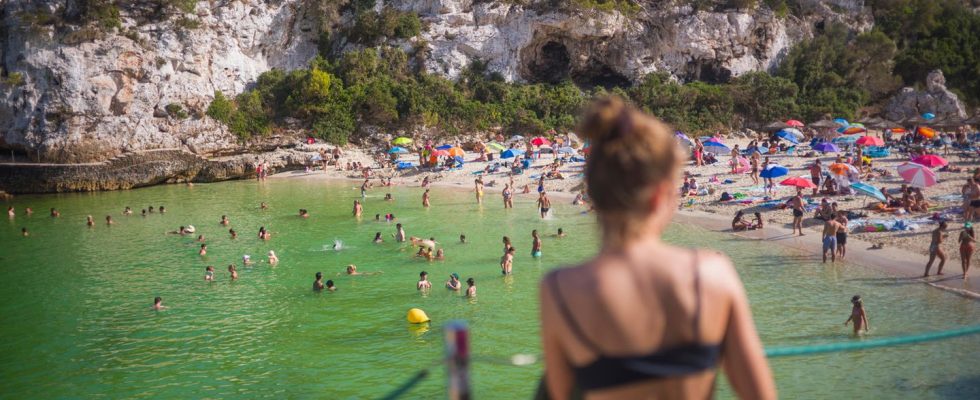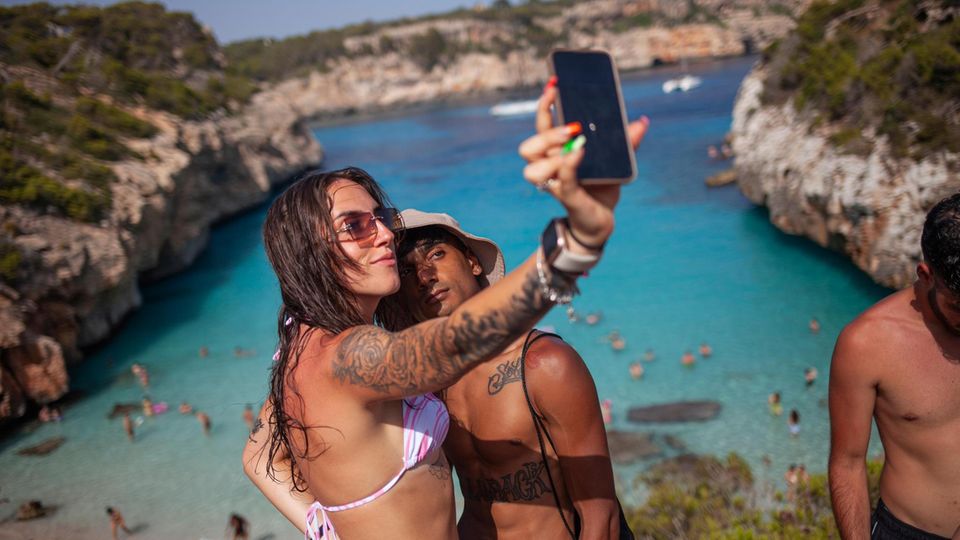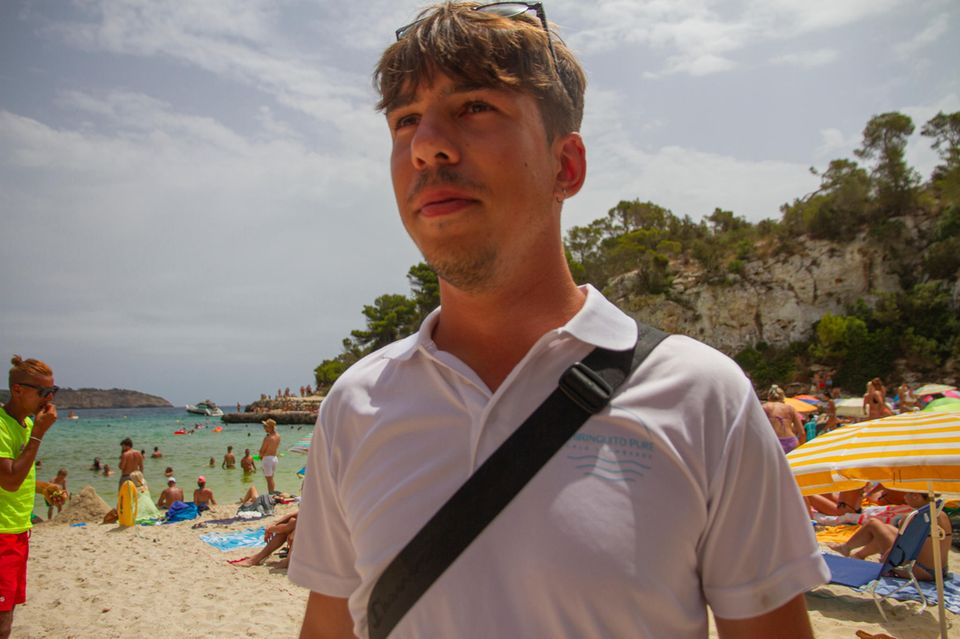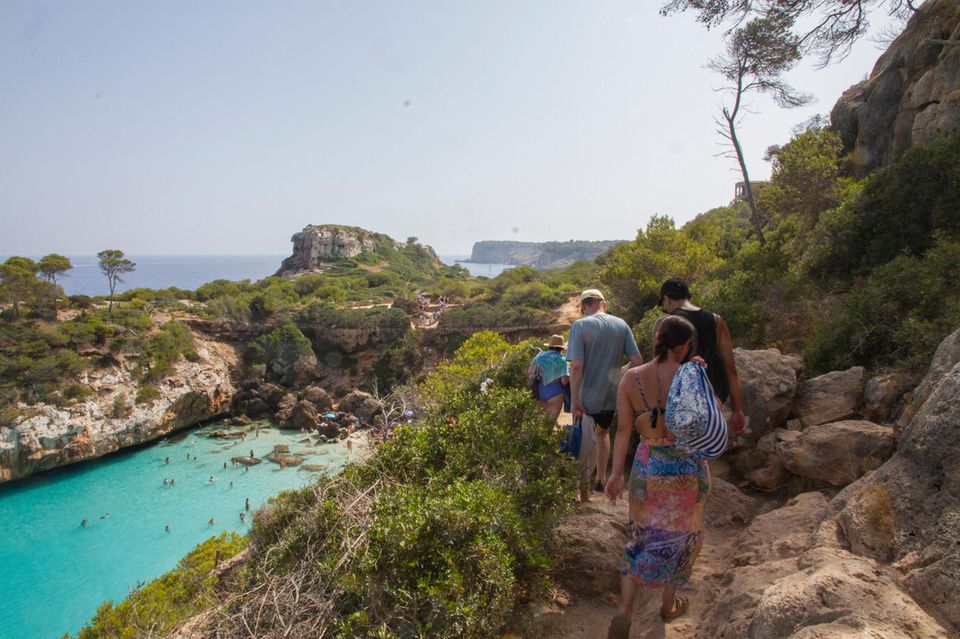The Cala Llombards and the Caló des Moro were once considered absolute insider tips on Mallorca. Now one bay is bright green, and the other loses more of its paradisiacal character with every Instagram post. What happened?
A good 20 years ago, the Mallorcans came to the Caló des Moro themselves to celebrate their birthdays. The bay between the rugged cliffs in the southeast of the island was halfway undiscovered and the world was right, one in which the predicate insider tip was still really true. Then came Instagram.
Today, in mid-July 2023, police patrol the streets in front of Calò des Moro. Visitors are no longer allowed to park their cars here, for them there is now a dusty parking lot in the middle of nowhere, the distance to the beach: about the time it takes sunscreen lotion to take effect. So now tourists in single file and with inflatable dolphins under their arms push their way through holiday home districts and along a dirt track to a bay. Which is now so full that there is a queue to get down to the water. While they are waiting, they take one to twelve selfies, which will probably soon end up on some digital bulletin board. Hashtag #nofilter, the water here is Caribbean enough.
Green broth instead of crystal blue water
There are English, French, Germans, Swabians. But you hardly meet Mallorcans anymore. Nur Tomeu, 16, from the neighboring village of Santanyi, stands under a parasol on the plateau overlooking the bay and sells water and soda. “It’s crazy,” says the boy with the curly pony. “People don’t even go into the water, they take a photo, put it on Instagram, and then 20 more people come every time.”

Caló des Moro beach is one of the most crowded beaches in Mallorca
© Tomeu Coll
With every #paradise, the Calò des Moro becomes a little less paradisiacal. The tourism vicious circle in the age of social media.
A few island bends further, Cala Llombards, otherwise actually the turquoise dream of every Tui travel catalog layouter. These days: a broth as green as the contents of a test tube in cartoons. If a pool were this color, hardly anyone would dip a big toe in the water. But the vacationers snorkel, paddle and crawl. A young couple kisses. A little further out, a group of boys dive off the cliff edge, right into a trail of tan droppings being pulled by a yacht.
Mallorca hoists the red flag
A green flag flutters at the lifeguard lookout tower. Lifeguard Macarena didn’t hoist it to match the color of her bay, but to signal to the guests: let’s go, have fun swimming without hesitation. Are you serious? “It’s absurd,” she admits, and then begins to tell an unbelievable story: just a week ago, the municipality responsible for Santanyi had the beach closed for three days. Macarena unfurled banners, the flag above her tower was deep red. Then, on the fourth day, the instruction came to open again. “But the color of the sea stayed the same. The water can’t heal in three days, can it?”
Oscar comes in, an employee of the beach bar here. He openly admits: “If we close here, we will lose money. It was good for us when it reopened.” The bar is run by a subcontractor on behalf of the municipality. Macarena and Oscar suspect a connection. The City Council of Santanyi leaves a request from the star unanswered.
Oscar works in the bar on Cala Llombards beach in Mallorca
© Tomeu Coll
The consequences of climate change
A call to the much more forthcoming Damià Gomis, who teaches physical oceanography at the University of Palma. The green water isn’t poisonous, he says, but it’s a sign of the island’s condition. The color comes from the plankton. And that thrives in Cala Llombards for two main reasons.
On the one hand because of the high water temperatures. Last summer, the waters around Mallorca exceeded 30 degrees. “These were the highest temperatures ever measured,” says Gomis. In mid-July 2023, the beaches of the Balearic Islands have already heated up to 29 degrees. And the traditionally hottest days of mid-August are yet to come.
On the other hand because of nutrients in the water, you could also say: because of human pollution. Drainage pipes lead into the sea around the bay. “The sewage has to be cleaned before it flows into the sea. But it’s never completely clean,” explains Gomis. “Boats also empty their dirty water here, although they should actually do it at the port. But because of the fees, the owners often avoid it.”
An island at the tipping point
The algae growth in the water is not a new phenomenon, says the scientist. “But due to climate change and the increased human presence on the coast, this is increasing. Studies show that the water quality has recently decreased noticeably.”
The star discovered the phenomenon in other bays, such as in Palmanova. Or at Cala Portals Vells.
At Cala Llombards, lifeguard Macarena only goes into the water when she really has to. Recently, an American vacationer said to her: “Shit is good for the skin!” Then he jumped in. An island at the tipping point – and its visitors pay for it. Literally.
“We can’t turn back time”
The Instagram beach of Calò des Moro is guaranteed to be free of algae thanks to an underground source of fresh water. Drinks seller Tomeu has other issues to contend with: Some tourists would seriously ask him if it was possible to pay by credit card here. In the evenings, when he goes on a garbage disposal tour, he sometimes finds heroin syringes and coke cans.
Holidaymakers on their way to Calò des Moro, a popular Instagram spot in Mallorca
© Tomeu Coll
What he takes in every day from his water and coke bottles goes to a foundation called Amics d’Es Caló des Moro – S’Almonia. She is committed to the renaturation and reforestation of the bay, to the preservation of one of the – as it says on a flyer – “last paradise on Mallorca”. There is a wooden box next to Tomeu. Visitors are supposed to brush the sand off their bodies in them. No grain should be wasted, and the beach shouldn’t shrink even more than it already has due to mass tourism. According to the foundation, 70 kilos of sand are collected every day, which are then dumped back onto the Cala Llombards.
A German emigrant couple is behind the foundation. Hans-Peter Oehm says on the phone that he and his wife bought the adjacent property 25 years ago to prevent a hotel complex from building in front of the bay. “We can’t turn back time,” he says. “Now we have to find a way to deal with these people.” 20 years ago, maybe 100 people came to Cala Llombards every day. And today? “A good thirty-five times that.” #wanderlust #paradise #nofilter
Read more about the topic here:




